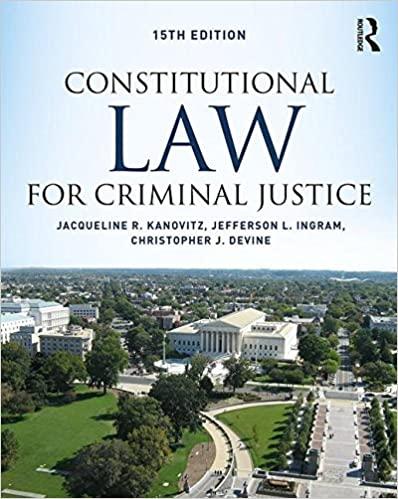Question
The question: Sally Semmler files a lawsuit against her employer, Discovery Software Corporation, alleging that the company discriminated against her because of her sex. Specifically,
The question:
Sally Semmler files a lawsuit against her employer, Discovery Software Corporation, alleging that the company discriminated against her because of her sex. Specifically, she alleges that she has not received a promotion because of her sex. After the close of discovery, the evidence shows: (1) that females have been promoted at the same levels as males in the company and (2) that Semmler is often late to the office and has lower than average evaluations.
Discovery files a motion for summary judgment and Semmler opposes the motion. Should the judge grant the motion under Rule 56(a) of the Federal Rules of Civil Procedure?
-------------------------------------------------
Rule 56. Summary Judgment
(a) Motion for Summary Judgment or Partial Summary Judgment. A party may move for summary judgment, identifying each claim or defense or the part of each claim or defense on which summary judgment is sought. The court shall grant summary judgment if the movant shows that there is no genuine dispute as to any material fact and the movant is entitled to judgment as a matter of law. The court should state on the record the reasons for granting or denying the motion.
-------------------------------------------------
My answer:
Summary judgment is a tool used to filter out cases that are not ready for trial. Judges will ascertain whether the evidence presented by the parties is substantial enough that a jury could render a verdict. Summary judgment is intended to determine whether there are genuinely contested material factual issues, not to try the facts. It avoids the risk of the jury having no legitimate basis upon which to find for plaintiff, as well as the delay and expense of trying unprovable cases. "Rule 56 provides that a motion for summary judgment may be supported by affidavits, depositions, answers to interrogatories, admissions, and admissible documents. Fed. R. Civ. P. 56(c)(1). Such documents are not always admissible in court itself, but they indicate that the party has evidence that would be admissible. When a motion for summary judgment is filed, the judge will determine if the movant has sufficient evidence to dispute the claim against him. If it is decided so, the movant has cleared his burden, and the burden shifts to the non-movant. Substantial and adequate evidence must be submitted by the non-movant, showing the need for a jury to render a verdict in the matter. If a party moves for summary judgment and properly supports the motion with admissible evidence, the opposing party must respond with countervailing evidence in order to avoid the entry of judgment against him. Fed. R. Civ. P. 56(c)(1). If this evidence is not presented, the motion for summary judgment will be granted. Summary judgment can be appealed and overturned.
Semmler v. Discovery Software Corporation is an example of how summary judgement is used in court. In her complaint, Sally Semmler alleged that Discovery Software Corporation (DSC), her employer, discriminates against her because she is a female. Thus, she filed a lawsuit against DSC. In her lawsuit she also asserts that she has not received a promotion due to her being female. Discovery ensues and evidence supporting her claim is not found. In fact, evidence of females being promoted at the same levels as males has come to light. Additionally, evidence of Semmler's poor work performance is brought forth. It is shown that Semmler has a history of arriving late and her evaluations are below average. After this new evidence to the contrary of Semmler's claims has surfaced, DSC files a motion for summary judgment under Rule 56(a) of the Federal Rules of Civil Procedure. Rule 56(a) of the Federal Rules of Civil Procedure states: A party may move for summary judgment, identifying each claim or defense or the part of each claim or defense on which summary judgment is sought. The court shall grant summary judgment if the movant shows that there is no genuine dispute as to any material fact and the movant is entitled to judgment as a matter of law. The court should state on the record the reasons for granting or denying the motion. Not surprisingly, Semmler opposes the motion. She now has the burden of presenting evidence of her factually experiencing workplace gender discrimination. If she has this evidence and it is admissible, the judge must deny the motion. However, if Semmler does not produce countervailing evidence, she will not have demonstrated the existence of a factual dispute for the jury to decide. If she cannot provide the necessary evidence, the judge should grant the defendant's motion for summary judgment.
Have I left anything important out regarding summary judgment? Should I make any change? Thanks!
Step by Step Solution
There are 3 Steps involved in it
Step: 1

Get Instant Access to Expert-Tailored Solutions
See step-by-step solutions with expert insights and AI powered tools for academic success
Step: 2

Step: 3

Ace Your Homework with AI
Get the answers you need in no time with our AI-driven, step-by-step assistance
Get Started


